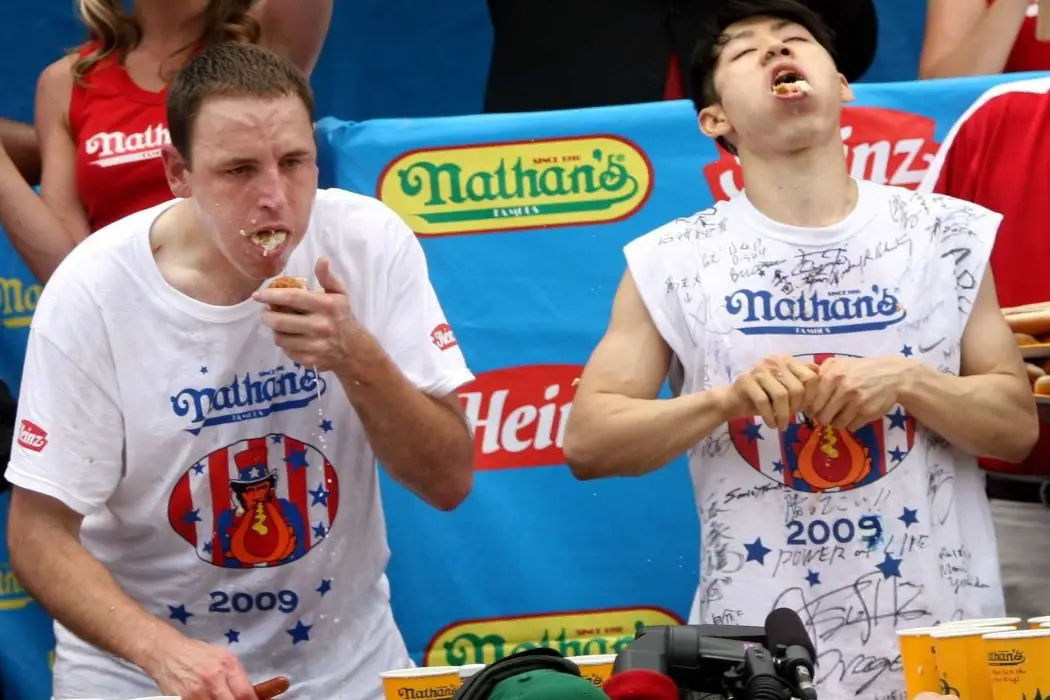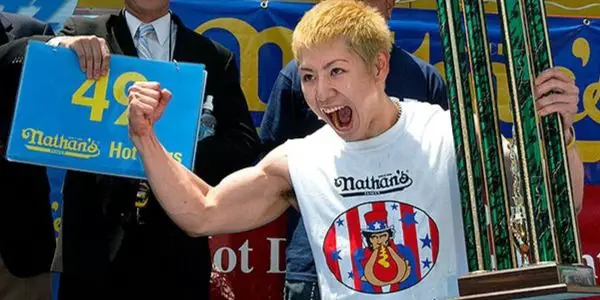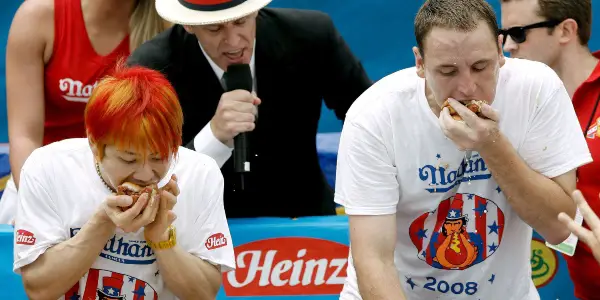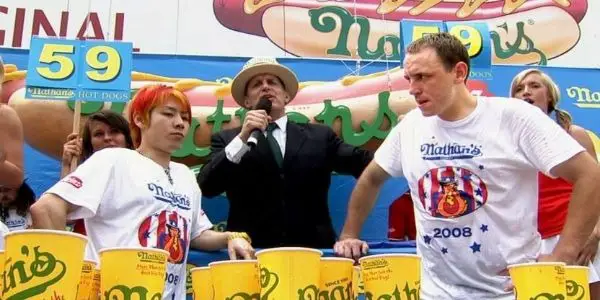30 FOR 30: THE GOOD, THE BAD, THE HUNGRY: You’ll Want To Throw Up & That’s Bad

Tynan loves nagging all his friends to watch classic movies…
When I was growing up I was a voracious collector of baseball cards. Topps, Upper Deck, Fleer. I had them all. But one of the releases that really amused me began when Allen & Ginter started going beyond the bounds of professional sports. I had a Fyodor Dostoevsky trading card to go with world champion Hot Dog eater Takeru Kobayashi; it was one of the first times I’d ever heard the immortal name.
Already I’ve indubitably split my audience: between those who have little to no idea what I’m babbling about and those who protest my narrow definition of professional sports. Well, folks, if we’re to believe this documentary, professional eating is a lot more serious than many of us have ever considered. For some, it’s a lifelong obsession.
The Wild World of Nathan’s Famous
Part of me can’t believe I’m watching The Good, The Bad, The Hungry and then recounting the events with a straight face. However, in another way, it makes complete sense because hot dog eating feels like the height of campy fun. When you have an announcer in a skimmer drawing up the competition as a mammoth struggle between god-like titans at the corner of Surf and Stillwell Avenue, there’s little room for doubt. Seated in the heart of Coney Island and mentioned in the same breath as sword swallowers and bearded ladies, somehow it all fits the image.
George Shea is the trumped-up mastermind and the gifted PR man featured on the mic since 1991. His original vocation was that of a fiction writer and he continued on that path turning Nathan’s into something of a quirky national phenomenon. Taking stock of his persona developed through the extended interviews, he is part ingratiating street peddler, part American mythmaker. To his credit, he saw the narrative possibilities behind competitive eating. In his own words, “This is dynamite.”
Because to create a sport with a true following you need a backstory. There entered the “Yellow Mustard Belt” which looks like it was slapped together with Elmer’s glue and bedazzled sequins from your local craft shop. It probably was. Whatever the facts, people somehow took hold of the tradition, becoming ardently involved in the whole aura of the perennial event.
However, the other revelation is the “sport’s” two fiercest competitors: Takeru Kobayashi and Joey Chestnut. We realize how serious they take this. It ceases to be a good-natured joke and becomes the new normal, in this case, a sport, when enough people come to accept it. In one sense it’s a terrifying testament on where humanity is willing to go and what we give legitimacy to. But aside from a few stomach aches, it seems like a harmless enough diversion. At first…
The Rise of Kobayashi
Japan was having quite the renaissance of eating competitions in the 1990s before they ever really gained traction in the states. Thus, Takeru Kobayashi‘s mythological rise on the speed-eating circuit was not conceived in a vacuum. He calibrated his skills as a youth in his homeland with a penchant for consuming large quantities of food while taking to heart his father’s urging to be #1 at whatever he set his mind to. As a poor student, he set his sights on eating instead.

His first trip to America came on July 4th, 2001 (only months before 9/11) and he came out of nowhere in the eyes of the domestic press by completely obliterating the previous records, eating upwards of 50 hot dogs. He instantly became a media darling and a fan favorite, despite his lack of English skills or American citizenship. It didn’t matter because he single-handedly jumpstarted Nathan’s into the big time.
In one overblown quote, some faceless announcer effusively praises the king of the hot dog eating world: “He is an alchemist who has transformed athletics into mathematics, mathematics into poetry, and poetry into history.” They even start mentioning Tiger Woods and Kobayashi in the same breath.
His training involves dexterity and stomach capacity drills showcasing this meticulous preparation devoted to all facets and each individual motion he undertakes. In fact, the precision bears a striking similarity to his countryman Ichiro. In one telling sound byte, he says, “If you can ignore taste, you can become a much stronger competitor.” This is an element of his success.
Even a wide-eyed Chestnut admits idolizing Kobayashi‘s initial success because “he sees [eating] as almost an art.” It transcends a mundane activity and becomes extraordinary. A statement like this is totally provocative. Now here I am indulging in the legitimization of this pastime and being pulled in. But that’s just it; he left the subculture behind and became mainstream. Now my trading card makes so much sense.
The Worthy Challenger
What really kicked the sport into high gear was the addition of a worthy challenger for the mustard belt. The up and coming American hopeful, San Jose-native, Joey Chestnut.
In one stolid-faced observation, Chestnut‘s brother notes, “We saw [Kobayashi] lose to a grizzly bear so we knew he was beatable.” Here we are given another completely absurd bit of dialogue and somehow its lent credence. At this same time, ESPN coverage of the competition added this personal connection and an even larger fanbase. Meanwhile, Chestnut undertook an all-encompassing regimen to do everything conceivably in his power to overtake his rival. There’s a killer instinct in him and it’s scary. Almost like he’s an athlete…

However, something darker also occurred with the rise of a contender. As the hot dog totals continued to skyrocket, the rivalry between America and Japan became more pronounced. Whether it was Shea‘s strategy to kick up more drama, deeply ingrained discrimination in the American populous, Chesnut‘s own take-no-prisoners quest for glory, or some mixture of all of these issues, Kobayashi was villainized.
His superstardom and acceptance were traded for a host of boos as he became the narrative’s default antagonist. There’s actually a palpable hatred toward Kobayashi as the great white hope Chesnut starts his ascendence. The worst part, it doesn’t feel like a gag; it’s real.
The Soap Opera Twists
Although Shea effectively crafted the early storyline, some of the subsequent twists create a soap opera unto its own. After finally losing to Chestnut in what felt like a very arbitrary run-off, there was the dubious “jaw injury” which looked to sideline the Japanese phenom in the following year’s rematch.
Then, to add to the maelstrom of sketchy rules and conflicting accounts, Kobayashi finally turned his back on Major League Eating entirely over a contract dispute. In the wake of his departure, Chestnut has been the runaway champion at Nathan’s without a hint of true competition for well nigh a decade. Oh, and there was another isolated incident where a protesting Kobayashi was arrested and removed from the premises of one of the competitions by security guards. It just doesn’t end.

If kitsch can be applied to food and sports, Nathan’s Hot Dog Eating contest has no equal. Are these people for real? How can they say these things with a straight face? However, one is forced to consider this to be as sickening as it is hilarious. The humor gives way to something far more disconcerting. These are people’s actual lives. These are real tears being shed. For Chestnut, it was his first defeat sustained against the reigning king. He admitted he “wept” and was utterly “heartbroken.”
For Kobayashi, the tears come in an on-camera interview where he recounts how his mother died from cancer right before one of his competitions in 2007. He ate in her memory because his continual relentlessness in his profession always gave her the courage to keep fighting too.
Certainly there are real elements to all of this, but it does feel a bit like we are being licensed to take advantage of this situation for the sake of drama. Is it too much to also read into the competition our country’s own inherent issues — whether ranging from xenophobia to gluttony?
Because director Nicole Lucas Haimes effectively crafts a humanizing path through this footage so we have all this stuff which should be, in all reality, a big fat joke or at least a momentary diversion, but it becomes an all- involving venture. It’s eye-opening and genuinely frightening just how important this has become to people. Not only those in the throes of competition but also the faithful masses who turn up to show their support. If nothing else, it’s a testament to the vacuous if not altogether negative obsessions that overtake the American public.
The Good, The Bad, The Hungry: Final Thoughts
Before I viewed Kobayashi and Chesnut as a pair of light-hearted folk heroes to be appreciated but not to be taken seriously. Having been submerged deeper into their world is troubling even as it says something about our society. One must only look at the outcomes and ask where did we go so wrong?
Our media, our politics, our modes of recreation have all become commoditized, divisive pieces of mass entertainment. We take some things way too seriously and others not serious enough. The landscape becomes a toxic cesspool constantly being added to and aggravated. This particular arena just happens to involve exorbitant amounts of frankfurters.
I don’t want to give the spotlight to The Good, The Bad, The Hungry and yet I’m part of the problem by propagating this story. I admit it. Frankly, it gives me a mild urge to upchuck and I didn’t just eat 73 hot dogs in 10 minutes before this. It’s small consolation to know it’s been done as recently as July 4th, 2018.
Ours is a nation, a land of the free and a home of the brave, where Joey Chesnut can become king. In one sense we can laud his tenacious if unorthodox, road to success. In another, we must rue the state of our culture. This is the nation that can rally around all that’s uplifting and decent about a story like Kobayashi‘s and then completely choke all the life out of it. Nathan’s World Famous Hot Dog Eating Contest is not the source of our nation’s problems but it is certainly a barometer to measure them.
Were you familiar at all with the world of Competitive Eating before? What are your thoughts of people like Kobayashi and Chestnut devoting their lives to these competitions? Tell us in the comments below.
The Good, The Bad, The Hungry was originally screened at the 2019 Tribeca Film Festival and will air on ESPN 2 on July 2, 2019.
Does content like this matter to you?
Become a Member and support film journalism. Unlock access to all of Film Inquiry`s great articles. Join a community of like-minded readers who are passionate about cinema - get access to our private members Network, give back to independent filmmakers, and more.
Tynan loves nagging all his friends to watch classic movies with him. Follow his frequent musings at Film Inquiry and on his blog 4 Star Films. Soli Deo Gloria.













